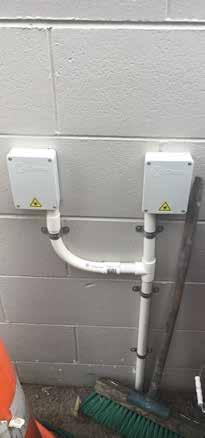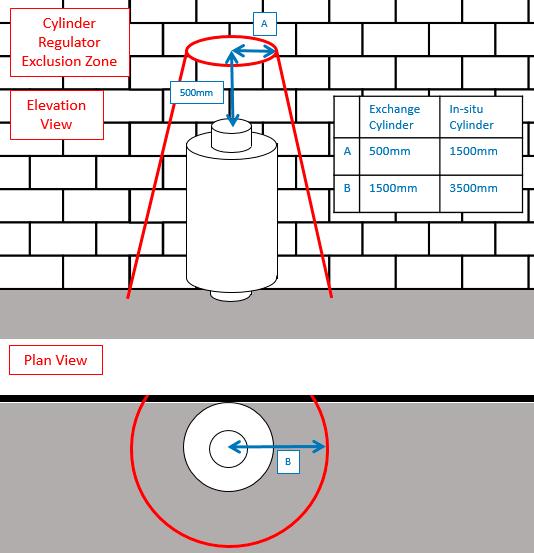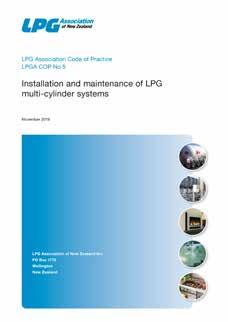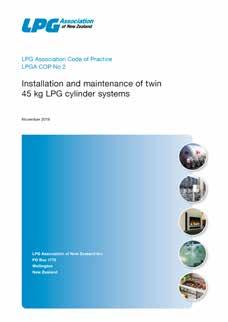
3 minute read
The word on gas
The word on gas Some important updates for the gasfitting community. Notification ID1829
LPG CYLINDERS & ETPs A new guide has been released to clarify the issue of installation of fibre External Termination Points (ETPs) within the hazardous area zone of LPG cylinders. The guide has been developed using explosive atmospheres Standard AS/NZS 60079, with input from an electrical engineering consultant and sector-wide consultation.
The NZ Telecommunications Forum (TCF)’s wiring installation guidelines, the Local Fibre Companies (LFCs) and Chorus installation procedures all advise against the installation of fibre ETPs within the hazardous zone of LPG cylinders.
LPG delivery drivers have identified multiple existing locations where fibre ETPs are installed within the LPG cylinder hazardous area. This has resulted in LPG suppliers suspending delivery, and ensuing discussions between the customer, the gasfitter and the companies that operate the fibre system.
Neither Chorus nor any of the other fibre installers believe the fibre ETPs are themselves a potential source of ignition. However, their advice not to install fibre ETPs within any hazardous areas also takes account of any future repair work that may be needed.
Part 28 of AS/NZS 60079 covers protection of equipment and transmission systems using optical radiation. Table 2 of the Standard specifies that optical radiation sources with radiated power of less than or equal to 15 megawatts are safe to be used in all atmospheres.
The LFCs and Chorus have confirmed they operate the ultra-fast broadband (UFB) network in New Zealand at less than 0.2mW, which is well below the energy levels required to create an ignition hazard. It has therefore been determined that a fibre ETP is not, in itself, classed as a potential source of ignition.
WHAT THIS MEANS
For gasfitters: The advice remains not to locate cylinders so that an existing fibre ETP comes within the LPG cylinder hazardous area. This is on the basis of good practice. For LPG suppliers: As fibre ETPs are not sources of ignition, LPG suppliers can continue to deliver to existing locations where a fibre ETP is present within the LPG cylinder hazardous area. For fibre installers: The current requirement not to install fibre ETPs within the LPG cylinder hazardous area remains. Potentially, future work may include tools that have the potential to act as a source of ignition, which will create a situation that the fibre installer will have to mitigate as part of their onsite risk assessment.

Gasfitters are advised not to locate LPG cylinders where fibre external termination points (ETPs) would come within the cylinder’s hazardous zone.
LPG CODE OF PRACTICE UPDATES Updates have been made to two important LPG Association Codes of Practice: 1 LPGA Code of Practice (COP) No 2: Installation and maintenance of twin 45kg LPG cylinder systems 2 LPGA Code of Practice (COP) No 5: Installation and maintenance of LPG multi-cylinder systems.
The updates reflect changes to the regulatory regime and reinstate the relevant clause and drawings from industry Standards, providing a user-friendly one-stop-shop for COP users, including gasfitters, architects and designers.
LPGA COP No 2 assists with the selection of suitable equipment and fittings, as well as recommendations on equipment maintenance. It should be read in conjunction with AS/NZS 5601.1 and is intended for use by gasfitters as a best practice guide for the installation and maintenance of domestic and commercial LPG cylinders up to 100kg capacity.
LPGA COP No 5 aids with correct cylinder location, the removal of condensate at the regulator, the selection of suitable equipment and fittings and recommendation on equipment maintenance. It should be read in conjunction with the requirements of the Health and Safety at Work (Hazardous Substances) Regulations, pressure equipment legislation and AS/NZS 1596.

Find both Codes of Practice at www.gasnz.org.nz/lpga in the LPG Safety dropdown.
Umbrella Cover: your insurance sorted
Find out more 0800 866 766

Find the updated LPGA Codes of Practice at gasnz.org.nz









